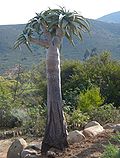| Aloidendron | |
|---|---|
 | |
| Aloidendron dichotomum | |
| Scientific classification | |
| Kingdom: | Plantae |
| Clade: | Tracheophytes |
| Clade: | Angiosperms |
| Clade: | Monocots |
| Order: | Asparagales |
| Family: | Asphodelaceae |
| Subfamily: | Asphodeloideae |
| Tribe: | Aloeae |
| Genus: | Aloidendron (A.Berger) Klopper & Gideon F.Sm. [1] |
| Type species | |
| Aloidendron barberae | |
 | |
| The distribution of Aloidendron in southern Africa. | |
Aloidendron is a genus of succulent plants in the subfamily Asphodeloideae. [2] It was split off from the much larger genus Aloe in 2013. [1]







